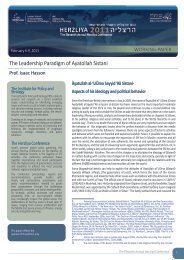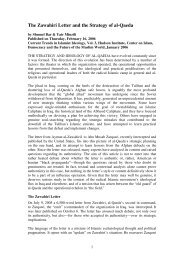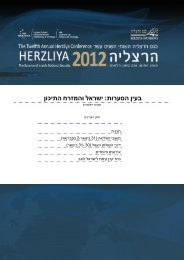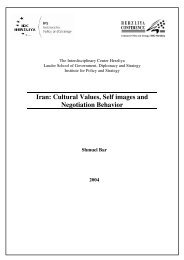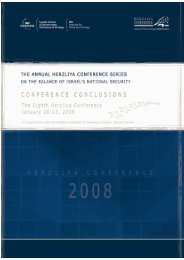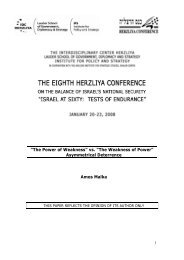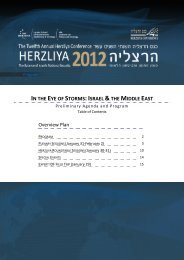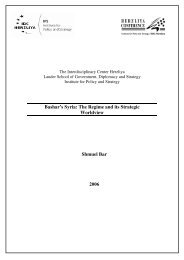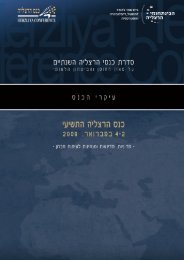Classical Islamic Paradigms of Deterrence and their Expression in ...
Classical Islamic Paradigms of Deterrence and their Expression in ...
Classical Islamic Paradigms of Deterrence and their Expression in ...
You also want an ePaper? Increase the reach of your titles
YUMPU automatically turns print PDFs into web optimized ePapers that Google loves.
The third part <strong>of</strong> the research focuses on deterrence concepts <strong>in</strong> contemporary Salafi-jihadi ideology. Aboutseven hundred years after Ibn Taymiyya’s death, his treatise is aga<strong>in</strong> very prom<strong>in</strong>ent <strong>in</strong> the Internet. TheSaudi-Arabian al-Qaeda ideologue Abu J<strong>and</strong>al al-Azdi (arrested 2004) even takes up Ibn Taymiyya’sargument <strong>in</strong> his own treatise "Incitement <strong>of</strong> the heroic fighters to revive the custom <strong>of</strong> assass<strong>in</strong>ations …killthe <strong>in</strong>fidel leaders," which refers to prom<strong>in</strong>ent cultural activists, politicians <strong>and</strong> military personnel. Al-Azdiputs special focus on the <strong>in</strong>timidat<strong>in</strong>g nature (ra'b) <strong>of</strong> assass<strong>in</strong>ation-techniques such as stabb<strong>in</strong>g with aknife <strong>and</strong> slic<strong>in</strong>g the throat (dhabah). Muhammad Bouyeri, the Muslim terrorist who assass<strong>in</strong>ated theDutch filmmaker Theo van Gogh <strong>in</strong> 2004, took these two texts as guidel<strong>in</strong>es. They served him as theologicaljustification, strategic-operative manual <strong>and</strong> div<strong>in</strong>e order. Also Abu Mus’ab al-Suri’s "Terror as Strategy <strong>of</strong><strong>Deterrence</strong>" <strong>and</strong> "Legal Terrorism" paradigms shed important light on contemporary Salafi-jihadideterrence paradigms. These paradigms mix classical <strong>Islamic</strong> doctr<strong>in</strong>es such as the law <strong>of</strong> "equal retaliation"(qisas) <strong>of</strong>fer a religious-ideological framework for attackers with WMD aspirations. In that sense, jihaditexts like "The jihadi-Nuclear Bomb – Ways to Enrich Uranium" cause a split-m<strong>in</strong>ded feel<strong>in</strong>g. On the oneh<strong>and</strong>, the text does not tell or teach anyth<strong>in</strong>g a moderately talented high-school pupil could not achievewith by himself with his chemistry set. Yet, the manual po<strong>in</strong>ts out that the possession <strong>of</strong> WMD would servethe jihadi cause. The authors call themselves "The Black Flags," which symbolize an apocalyptic doomsdayvision <strong>of</strong> Islam.The last part <strong>of</strong> the research will return to the <strong>in</strong>itial argument <strong>and</strong> suggest ideas how to address thesemiotics <strong>and</strong> religious-psychology <strong>of</strong> jihadi sub-state actors. Perceptions <strong>of</strong> salvation <strong>and</strong> non-deterrabilityshould be attacked at <strong>their</strong> very ideological roots (See parts 7.b,c <strong>and</strong> d <strong>of</strong> the paper). Some jihadi groupsmay be held <strong>in</strong> check if they start doubt<strong>in</strong>g <strong>their</strong> own culture. In the m<strong>in</strong>d <strong>of</strong> radicalized perceivers, "div<strong>in</strong>ereward" can be replaced with "div<strong>in</strong>e punishment." This disturbs, unsettles <strong>and</strong> raises questions amongjihadis. Most importantly, it has the potential to deter them psychologically. This requires the build-up <strong>of</strong>"<strong>in</strong>tellectual firewalls" (Shmuel Bar, 2012) that address religious-psychological key signs (symbols, beliefexpressions, rituals).IntroductionMuslims <strong>and</strong> Doctr<strong>in</strong>aire Global JihadisMany <strong>and</strong> diverse Muslim cultures foster peaceful <strong>and</strong> universal human values. Muslims <strong>of</strong>ten welcometravelers with a hospitality <strong>and</strong> acceptation that surpasses the welcom<strong>in</strong>g <strong>of</strong> strangers <strong>in</strong> Western cultures.However, the Muslim world is shaken <strong>and</strong> agitated by terrible conflicts. Some <strong>of</strong> the fr<strong>in</strong>ge groups with<strong>in</strong> itare extremely violent. Such groups draw on popular concepts; they dra<strong>in</strong> the conceptually rich soil <strong>of</strong><strong>Islamic</strong> meta-culture <strong>in</strong> order to prosper. 1 As a matter <strong>of</strong> fact, certa<strong>in</strong> streams <strong>in</strong> Sunni culture adoreviolence, punishment <strong>and</strong> fear <strong>in</strong> an almost cultic manner. The sectarian ideology under exam<strong>in</strong>ation is"salafi-jihadism" (al-salafiya al-jihadiyya), a sub-trend <strong>of</strong> Sunni Muslim fundamentalism (salafism), which isrooted <strong>in</strong> cultic <strong>and</strong> violent Interpretations <strong>of</strong> <strong>Islamic</strong> belief; the Internet is the most important platform forits dissem<strong>in</strong>ation. 2 However, neither does the modern idea <strong>of</strong> jihad orig<strong>in</strong>ate out <strong>of</strong> a vacuum, nor is it byany means a new or young phenomenon. Firstly, terrorist trends <strong>in</strong> any culture emerge <strong>in</strong> contexts <strong>of</strong>repression (perceived <strong>and</strong> real), social <strong>and</strong> political change as well as occupation. Secondly, precursors <strong>of</strong>jihadi activism can be found <strong>in</strong> doctr<strong>in</strong>aire, militant <strong>and</strong> <strong>Islamic</strong> resistance movements, respectively on the1 Philipp Holtmannn (ed. Rüdiger Lohlker), "The Symbols <strong>of</strong> Onl<strong>in</strong>e Jihad – How Jihadis Foster Central Myths <strong>in</strong> E-Environments to GuideOnl<strong>in</strong>e-Groups", New Approaches to the Study <strong>of</strong> jihadism, Vol.2, Vienna: University Press, 2012.2 Parts <strong>of</strong> the dangerous ideological reservoir, which jihadis tap, are popular Muslim resentments aga<strong>in</strong>st the West.5



